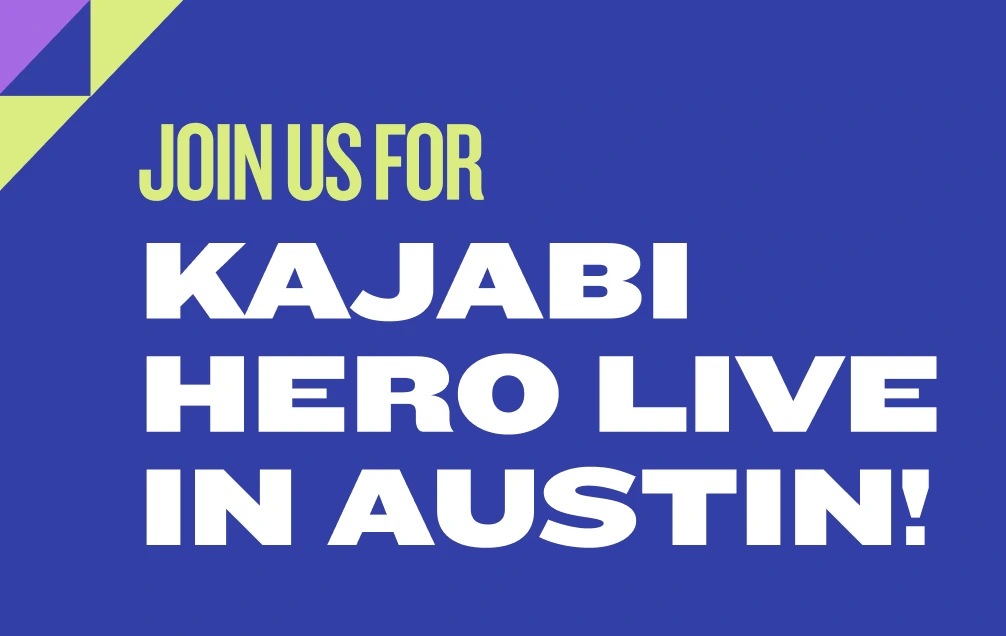
How to make money online with digital products
Get free expert insights and tips to grow your knowledge business sent right to your inbox.
Making money online isn’t just a passing craze. It’s entirely possible to create and sell digital products from your home. You can use the knowledge and skills you already have, working part time or full time.
How to make money as a content creator
Content creators can make money by selling content that leverages their expertise. More than 50,000 digital entrepreneurs sell online courses, coaching programs, and memberships on Kajabi. We’ve compiled some of the best practices and proven tips from our Kajabi Heroes to offer you insights on creating and selling digital products.
In this guide, we’ll break down the exact steps to sell your digital products online and do it in a sustainable way. But before we dive in, let’s look at a few of the perks of being a digital creator.
Benefits of selling digital products
If the thought of starting a business brings physical storefronts and warehouses of inventory to mind, think again. Selling digital products is far more accessible. Here are just a few of the benefits of making money online with digital products:
- You don't have to worry about logistics: When selling physical products, you have to think about storing inventory, packaging, and shipping. Since digital products live online, you only have to worry about hosting your product.
- Low barriers to entry: When selling physical products, you often need huge upfront investment in manufacturing and stock. To produce digital products, you only need a steady internet connection, a computer, and access to a few digital selling platforms.
- Huge profit margin: You can keep a vast majority of your sales as profit. You may have to pay for things like software but digital products are often more profitable than physical products.
- Flexibility: There are lots of digital products that make money online. And most of them are easy to create using knowledge you already possess.
What are digital products?
Digital products are intangible, non-physical assets that are sold online. After purchase, they are accessed online or downloaded to a computer or other device.
Digital products are mostly virtual. In some cases, they may have a physical component. For example, a membership site may offer PDF downloads that can be printed. An online course may include a workbook and resources that are mailed to students. If you're looking for a way to design your workbook, Brush Galaxy provides assets for digital artists in a PDF format in the form of tutorial guide, or brush plug-ins, that can be directly used in a digital art software.

The best digital products for making money online
You can sell just about any digital product online. You’ve probably purchased some of them yourself: ebooks, stock photography, online courses, digital graphics, software, and videos. None of these items can be tasted, touched, or held, yet all of them provide value to the customer.
That’s really the secret to making money online with digital products. If you have valuable information or a digital asset that other people want, you can sell it online as a digital product. People will pay for smart solutions and information that helps them save time or create a better life for themselves.
Here are four digital products that have been proven to make money online:
1. Online courses
Selling online courses allows you to turn your expertise into an additional source of income. People in marketing, yoga, productivity, interior design, guitar, and social media are all making money online with digital products.
Online courses may be delivered by video, audio, and/or text. Some courses are 100 percent digital. Others offer a coaching component, delivered in group calls on Zoom.
Examples of successful online courses
Some of the most successful courses were created for a niche audience to solve a very specific problem or desire.

Shine Life Design teaches courses on women’s empowerment. Its founder, Jaime, was a Senior Workshop Leader and Trainer for 11 years. She’s led over 150 live weekend courses, retreats, telecourses, and leadership programs.
Today, she uses that experience to “empower women to honor themselves, discover their personal truth, and lead joyful, soul-fueled lives.” She offers courses, a retreat, and a community membership that help transform her students’ lives.

Color Code Classroom offers training to people who have taken the Color Code personality assessment online. It’s designed to help people build stronger relationships in all areas of their life, based on their unique personality type.
This course is actually an upsell to another product. Customers may have been given a personality test at work. They know their “type,” but they don’t know how to use that information. Color Code Classroom solves that problem.

Wendy Conklin, the founder of Chair Whimsy, specializes in creativity. Her business grew out of her love for chairs and creative spaces. In her course, she teaches people how to create their own inspiring spaces with boutique chairs. The course also attracts potential customers for her done-for-you service.
2. Membership sites
If you're looking to earn recurring revenue with a digital product, membership sites might be the perfect option for you. Membership sites allow you to deliver information or digital downloads to customers on a monthly, quarterly, or annual subscription basis.
Members get access to premium content, exclusive group discussions, Q&A sessions, and workshops. Each month, they’re alerted when their deliverables are ready, and they log into the membership area to find it.
While keeping a membership site alive needs more commitment than creating and selling a one-off course, the payoff can be worth it. The monthly subscriptions create a recurring revenue that you can count on.
Examples of successful membership sites

Kimmay wasn’t happy with the way her body looked. Then, at a bra fitting in NYC, she realized she wasn’t the only one with body-image issues. She decided to turn that negative self-talk into something positive. Hurray Kimmay was born.
Today, Kimmay is an undergarment educator. But undergarments are just a means to an end. In her membership site, she teaches women to stand tall, lead with their heart, and say hurray.
Members receive coaching, articles, videos, events, monthly women’s circles, and more. They learn to love themselves inside, outside, and underneath.

Jewel Education offers a mastermind business membership for photographers. Memberships include ongoing and signature education.
This membership only opens twice a year. When the membership isn’t open, visitors can buy digital courses that cover a range of training, as well as templates and systems designed to help photographers make more money.

Hay House Writer’s Community Membership is for beginning, aspiring, and published authors. In it, writers get step-by-step guidance writing and publishing their books.
This membership was founded by Hay House, an independent publishing company and self-help publisher. Their membership site is part support group, part learning experience. It provides a platform for the company’s CEO to share his decades of knowledge with aspiring authors
3. Community sites
Community sites are similar to memberships. But the goal here is to provide a learning and networking space for people with similar interests. Rather than delivering monthly content and training, they allow people to interact, learn from one another, and build relationships.
Communities may be paid or free. Course creators often create a free community for students of their premium courses. They may also create a paid community that serves as an upsell to their course. In both cases, the community helps members interact with other students, enhancing their learning experience.
To create a thriving online community, you need to moderate it well. This means setting up rules about what members can post, not allowing off-topic blog and content promotion, and leading discussions on a regular basis. A number of communities also run AMA (Ask Me Anything) chats with leaders in a niche, so members can learn from experts in their field.
Examples of successful community sites

Illuminate Consulting was founded by Dr. Krysti Wick, Chiropractic Coach, Speaker, and Practice Growth Strategist. She helps women chiropractors become entrepreneurs as well as healers.
This community promises to heal and grow your practice from the inside out. It offers a proven framework for growing profits, high-level coaching, and support from other women chiropractors on the same journey.

Screenshot of a landing page for "your 4-part plan for landing your dream clients in 2021"
Inspired Organizer is a community for organizer coaches. In it, coaches learn how to make the client’s life simpler from square one. Members get access to workshops and can network and learn from one another.

Next Level Catholic Academy offers a community for students of the Science of Sainthood training. In the course, students have a place to ask questions, discuss important topics, and support one another.
4. Online coaching
If you’re passionate about your topic and want to help people achieve success faster and easier, online coaching may be the best digital product for you.
The best online coaches have specialized knowledge and experience in a specific domain, and they help people achieve their goals in that field. They may provide expert advice on a wide range of topics such as health and wellness, personal finance, career growth, and business management.
Online coaching generally comprises hourly one-to-one or group coaching sessions, where coaches discuss their client's goals and progress, and provide feedback.
Examples of successful community sites

Lauren Bongiorno, a type 1 diabetes health coach and author, helps people get in control of their diabetes through personalized virtual coaching. She helps people create a routine for workouts, follow a diet, reduce their anxiety, and improve their relationship with food. She offers one-to-one as well as group coaching sessions.

Tamsen Horton is the host of the Preneur Business Klub (PBK), an exclusive club for professionals who use Kajabi to run their online business.
She uses her expertise as an attorney to offer legal advice on running an online business through Kajabi. She provides shortcuts, tips, best practices, and also answers queries from customers about the legal issues.

Genuine Attraction by Edward Baxter helps divorced men get back on their feet after divorce. Edward teaches men to overcome shyness and date women who wish to have long-lasting relationships.
He offers a video course, an online community, as well as coaching to help men heal after a divorce and move on.
How do you sell digital products online?
Selling digital products online is easier than you might think. Follow these five steps to get started.
Step 1: Build an online presence (website) for your products
A website gives you a place to show off your product and engage with customers. It provides free content that helps people understand why your product is valuable. It also has landing pages that sell your products.
If you’re worried that you’re not technical enough to build a website, don’t be. A platform like Kajabi does all the heavy-lifting, so you can focus on what you do best: creating valuable digital content.
Step 2: Create your digital product
Once you've set up your website, it’s time to create your product. Here’s how to make sure your product hits the mark and sells well.
Research your topic or niche carefully
To make money online with digital products, you must study your niche carefully. You need to:
- Identify the topics people are actively searching for
- Discover the topics that haven’t been covered yet in your niche
- Find the areas where you can add value
For instance, if you're an expert in baking, you might find there's not much content or material available online for professional bakers in the keto space. This helps you narrow your niche and differentiate your offering.
You'll also want to find the specific keywords people are searching for when looking for your topic. Tools such as Google Keyword tool, Ahrefs, and Ubersuggest can be helpful here.
Analyze your target audience
This step involves researching the specific pain points your product will address. It helps craft a better product that meets your audience's needs. It also helps you write better copy for your website and marketing materials.
The best way to get a pulse on your target audience is to hang out in their online communities, seek out reviews of similar products online, and if possible, talk to a few people in your target customer group.
Your goal is to find your customers’ pain points. For instance, if you're selling a diabetes management program, you'll want to find the challenges diabetes patients face, areas where they need help, and the content and coaching they want and need.
Create content for your digital product
For all digital products, whether membership sites, coaching programs, or online courses, you need to create content to deliver value. For an online course, it could be videos or slideshows. For a membership site, it could be articles, ebooks, or webinars. For coaching programs, it could be webinars or training sessions.
To make your content valuable, use all of the research you’ve done to create specific, actionable content for your customers. Make sure all your content helps people understand (and desire) your product.
Step 3: Set your price
The key to making money with digital products is to set an appropriate price. Your price needs to cover your costs for creating and selling the product, and then some. It also needs to be fair to your customers.
Some digital entrepreneurs say you should offer 10X the value you ask people to pay. While 10X seems steep, this mindset is right. Your customer should always feel that they got more value than they paid for.
How do you find this magical price point that’s fair to you and your customer?
Start by considering the real value of your product. If you're offering a one-to-one coaching program to help freelancers earn a high income, that's worth a lot more than a one-hour video on the same topic.
Then look at your competitor’s prices. Ideally, you want to set a comparable price. But if you can be profitable offering high value at a lower price, you’ll win a lot of business.
A good example of a digital product that uses this strategy is The Last Amazon Course. Its price is just $1 per week, with no upsell.

As long as you’re an active member, you get complete access to the training portal. That includes 375+ videos and 45+ hours of training.
Because digital products typically have a low overhead, it’s entirely possible to set a ridiculously low price and sell to a large number of customers. But “digital” doesn’t always mean “cheap.” Many digital creators charge $2,000, $5,000, and more for their digital products because the value is so high.
One last thing: Your payment options can make an expensive product feel accessible even to people on a tight budget. Here are some payment options to consider:
- Lifetime access: This means customers pay you a one-time price and get lifetime access to your product. This model works best for products such as an online course or coaching.
- Access for a limited period of time: In this payment structure, you allow your customer to purchase or subscribe to your services for a specific period of time for a set price. Customers typically commit to your services on a weekly, monthly, or yearly basis. This works well for online courses and communities.
- Subscription-based: In this model, the customer pays a recurring price at regular intervals for access to your product or service. This model could work well for memberships, communities, and coaching.
- Bundle pricing: This means bundling a few of your digital products under one price. For instance, if you're selling online courses, you might bundle that together with an online community, memberships, or coaching.
Some online creators also allow customers to pay in installments. To do this, set your one-time-payment price. Then break it into a specific number of monthly payments.
Be aware, with payment plans, there’s a small risk of students defaulting and failing to pay the amount they owe. To compensate, you can charge more for a payment plan.
For instance, let’s say you set the price of your digital product at $1,000. To create a payment plan, you divide that into four monthly payments of $250. Then, you add a small “convenience charge.”
On your landing page, you offer one payment of $1,000 or four payments of $275. Many of your customers will be happy to pay the extra money to spread out the cost of your digital product.
Step 4: Build a landing page
A landing page is a web page that aims to get every visitor to take one specific action. You can use a landing page to generate leads, promote your products, or confirm a new purchase.
Here’s a landing page that promotes Amy Porterfield’s Digital Course Academy:

She’s no longer actively selling the course, so she asks visitors to sign up for the wait list. That way, when the course opens up again, she’ll have a list of people who are interested in buying from her.
Your landing page can be long or short, depending on its goal. It should describe your product, its benefits, and how it will help your customers. It should always have a clear call to action.
Step 5: Promote your digital products
Once your website and landing pages are built, it’s time to promote your product so you can make money online. Here are some reliable ways to promote your digital products:
Participate in niche communities
To kickstart your product promotion, aim for niche audiences in forums and communities that focus on a specific topic.
Niche communities bring together a common interest, goal, or value. For example, Goodreads is a niche online community for book lovers to find new book recommendations, leave reviews, and discuss their favorite books with like-minded readers.
When participating in niche communities, your goal shouldn't simply be to drop links to your product or landing page. Instead leave insightful comments on discussions and engage with other members. Position yourself as an authority on your topic, and your audience will naturally gravitate towards your products.
Use social media
Social media channels such as Twitter and Facebook offer are a great place to build a following and eventually get them to buy your products. The key is to understand what type of content works best on which social media platform and create share-worthy content for those platforms.
You don’t need a huge social media following to make sales. A few hundred followers are enough to get your first few sales.
A good example of a digital creator who has leveraged social media well is Packy McCormick, who runs the successful newsletter, Not Boring. It has over 40,000 subscribers and earns money through advertising.

Partner with influencers in your niche
Influencer marketing is a strategic way to introduce customers to your product and get them to buy. Nearly 40 percent of Twitter users say they’ve made a purchase as a direct result of a Tweet from an influencer. Nearly half of all consumers (49 percent) rely on influencers for product recommendations.
Influencers generally have a sizable following on popular social media platforms and use channels such as blogging, videos, and email to regularly connect with their followers.
You might partner with influencers to review your online course, or participate in an Ask Me Anything session in your paid community or membership site.
For more information on how to get started with influencer marketing, check out this helpful guide.
Leverage affiliate marketing
As far as promotional channels go, affiliate marketing is both effective and simple. You don’t have to search for audiences. Your affiliates do it for you.
What’s more, you only need to set affiliate marketing programs once, and they keep running in the background without much effort on your end. They work especially well for online subscription and eCommerce businesses.
If you sell your digital products on Kajabi, it has a built-in affiliate program creator. It lets you track affiliates’ form submissions and conversion, track registrations, and create detailed reports of how much you earned from affiliate programs.
What you can also do is create a referral program. It is more personal than affiliate marketing but just as effective. For example, the money-making app Honeygain offers its users a referral program where they get a share of the profit from each referral they bring.
Focus on email marketing
Email marketing boasts a 3,800 percent ROI ($38 for every $1 spent). It's one of the most efficient ways for digital creators to reach customers and drive traffic back to their landing pages.
Here are a few pro tips pulled from our email marketing guide:
- Use pop-ups on your website and freebies to collect email addresses.
- Promise only what you can deliver, be it free coupons, discounts, or ebooks.
- Set up automated email campaigns to convert prospects into customers.
- Add interesting calls-to-action to drive subscribers to your product.
Use paid advertising
Paid advertising allows you to reach interested customers on search engines, social media, and other digital platforms. Ad creators pay either for ad impressions or clicks.
Impressions refer to the number of people who view your ad, they’re best for driving awareness about your products. On the other hand, if you want to drive traffic and sales for your product, click-based ads are more effective.
The best types of ads for digital creators include pay-per-click ads on Google, video ads on YouTube, and lead generation ads on social media. These allow you to drive traffic to your website, explain the benefits of your products, and build your email list.
Best practices for selling digital products online

We’ve gone over the basics of making money online with digital products. Now let’s look at some best practices that will help you stay profitable and grow your income.
Choose the right digital product to sell
Ideally, the digital products you sell online should be closely related to your professional experience, passion, and skills. What special skills or knowledge do you have that others would be willing to pay for?
For instance, a yoga instructor might sell an online course on meditation and popular forms of yoga. An art teacher might sell digital photographs for commercial use, or create design templates for websites.
Don’t wait to think about profitability
The time to think about profitability is before you create your digital product. Ask yourself whether you can realistically turn a profit with your idea.
- Is there a real interest in your product? Are you offering a solution or transformation that people are willing to pay for?
- Do a lot of other companies offer a similar product or similar solution? Is your offer unique enough to stand out?
- Can you set a price that’s higher than the cost of creating, marketing, and maintaining your product?
Market demand
Is there sufficient demand for your product? If there's not much demand, it will be difficult to sell enough products to create a steady income. It may also be hard to set a price that covers your costs.
Competitive strength
If the market is too crowded, you may need to spend more simply to get noticed by customers. This may reduce the profitability of your product.
Price
How expensive will your product be? There are pros and cons to every price point.
A low-cost product is easier to sell, but it gives you a smaller profit margin. You may not be able to dedicate the time and resources that your customers want and need. And without positive reviews, you may struggle to make enough sales to be profitable.
A high-priced product gives you a bigger profit margin. With only a few sales a month, you can hit your income goals. But you’ll have to work harder to convince customers to buy. And high-value products demand more customer support on the back end.
Keep your costs down
When calculating your profit margins, look at your recurring costs. These usually include:
- Your website
- A landing page builder
- Your email service
- Marketing and advertising
- A digital payment gateway
The best way to keep your costs low is to use as few tools as possible to set up your online store. The more tools you use, the more you have to worry about integrations and breakage. And in many cases, more tools end up costing more.
Most online creators grapple with this issue. They pay a premium price tag for each software they use, but they end up using only 10 percent of the features they pay for.
It can help to use a single platform that does everything. It can be more affordable than piecing together an online business with ten different tools that don’t place nice with one another.
For instance, with a tool such as Kajabi, you get access to
- Hosting: Host your website, landing pages, products, and blog content in one place.
- Email marketing: Kajabi’s email marketing solution has powerful built-in analytics, tagging features, and automation.
- Customizable themes: Get templates that make it easy to build an online presence that fits your personality.
- Affiliate management: Kajabi allows you to easily manage affiliates for your digital products.
- Payment processing: Kajabi integrates with popular platforms such as Stripe and PayPal to accept payments for your products.
Watch your metrics
To stay profitable, you need to stay on top of what’s working and what’s not. You must track website visits, downloads, purchases, referrals, and your most visited product pages. You should also keep an eye on your profit margin and operating expenses.
This helps you figure out which of your marketing activities are working well, which distribution channels you need to double down on, and which areas may be draining your business of profit.
Turn existing customers into your biggest advocates
Turning existing customers into your biggest promoters is the best way to increase the reach of your digital products. Most consumers (84 percent) trust product recommendations from friends and family more than ads or branded content.
One of the easiest ways to turn your customers into advocates is to provide excellent customer service. Be available for questions, doubts, and concerns. This stands out in an age when consumers are used to everything being automated.
Another way to keep your customers happy is simply to deliver on your promises. Just do what you say you’re going to do. Easy peasy.
Ready to start making money online?
It’s a great time to become an online creator. The world's transition to digital learning and interactions have been fast-tracked over the last few years. That makes your transformation to digital entrepreneur easier than ever.
So get started today. Turn your idea into a digital product, and let Kajabi help you make money online. You can get started today with a free, 14-day trial.
Find more blog posts by category:
Create Your Product
Build Your Business
Grow Your Business
Kajabi News
Self-Made













